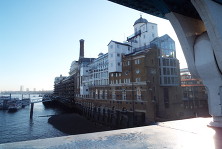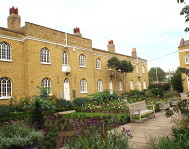








Chumleigh Gardens is a Grade II listed U shaped range of early 19th almshouses built by the Friendly Female Society centred around a delightful multi-cultural garden. Built to provide homes for aged single women, there are many women of retirement age today who would be overjoyed to be given a home there, situated in the middle of the open space of Burgess Park. Sadly due to bomb damaged during the second world war, they no longer provide social housing but, after much needed restoration and refurbishment work, were bought into use as a community hub during the formation of Burgess Park.
Friendly Societies were established throughout the country from the end of the 18th century and were set up as a mutual assurance society where members paid subscription into the society’s funds and when unable to work through illness or accident were paid an allowance until they were fit enough to work again. The Friendly Female Society that built the almshouses in Chumleigh Gardens was a little different in that the subscribers were from the upper and middle classes who made payments to women over 70 who were destitute and living in desperate poverty but, it was emphasised, of good and pious character.
The Society was established in 1802 and a London-wide organisation. There is no record of the founding members but counted royalty amongst its patrons including Caroline of Brunswick, the Princess of Wales whose husband was to become George IV. The Society was to be run “solely by love, kindness and absence of humbug”, for women and by women. Men were allowed to subscribe and donate but were banned from attending the general meetings though allowed to vote through a proxy held by a female subscriber. The aims and methods of the Society were described in their Annual Report of 1811:
“Among the various objects of Christian sympathy and benefice which present themselves, there is one class that seems peculiarly entitled to the humane notice of the female heart; namely poor aged women of good character, some of them are widows, destitute of a husband’s industry, a husband’s counsel, a husband’s sympathy. There are others who have been reduced from ease and competence by what are called the accidents of life to a state of dependence and want. Many also who have spent their days and their strength in servitude have outlived their capacity to work without having been able to pay up a suitable provision for the winter of life.” This led to the establishment of “an institution for their relief, under the denomination of the Friendly Female Society.”
By 1802 the Society had received over £472 and relief of 1 shilling or 1s 6d (5 to 7.5 pence) was given to 103 women. In 1804, permanent allowances of 5 guineas a year to 20 poor women over the age of 70 were commenced. In 1808, the Society had £1401 in hand and were able to help 1577 women. As the Society’s income increased so too did the number of women receiving annual allowances and blankets, shawls and spectacles were also provided.
In 1819 an appeal was launched to raise funds to erect almshouses. A site was found in Chumleigh Street, Camberwell and the first five houses were built, each containing four rooms. The almshouses were opened in 1823 and became home to 20 women who also received 8 guineas a year. Further houses were added in 1847 which accommodated a further 20 women and in 1863, a further seven houses were built in Brixton which provided homes to a further 28 women. When the almshouses in Camberwell were built, they were mostly surrounded by fields and market gardens but these were soon built upon. By 1875, they were enclosed by streets of small terraced houses, a ginger beer factory (R W Whites) and a bible binding factory (Watkins) was a couple of streets away.
In 1939 the Society launched an appeal to modernise the almshouses, now called the Friendly Almshouses which was felt to be more in keeping with the times. They still provided a home to 68 women of pensionable age who each had a room, a small garden, the use of a kitchen, coal in winter and a small pension. Events overtook the modernisation appeal and the almshouses in Camberwell suffered badly in World War II bombing raids. They were left derelict for years but fortunately escaped demolition. The almshouses in Brixton also suffered bomb damage but were repaired and extended, and still offer housing to women over 50.
Chumleigh Gardens now provides office space for park rangers, and accommodation for a café and a nursery, and offer a temporary home for the Cuming Museum while remedial work after the fire is completed at their permanent space in Walworth Town Hall.
Source: Hilda Martindale, The Friendly Almshouses: A short sketch of the Society and its work (1940)
Chumleigh Gardens, Burgess Park
Web discoveries
- UK Casino Not On Gamstop
- UK Casino Not On Gamstop
- Non Gamstop Casino
- Casinos Not On Gamstop
- Non Gamstop Casinos
- Non Gamstop Casinos
- Non Gamstop Casino
- Casinos Not On Gamstop
- Casino Sites Not On Gamstop
- Slots Not On Gamstop
- Casinos Not On Gamstop
- UK Betting Sites Not On Gamstop
- UK Casino Not On Gamstop
- Best Non Gamstop Casinos
- Betting Sites
- Non Gamstop Casino Sites UK
- Best Non Gamstop Casinos
- Non Gamstop Casino
- Casinos Not On Gamstop
- Non Gamstop Casino Sites UK
- Horse Racing Betting